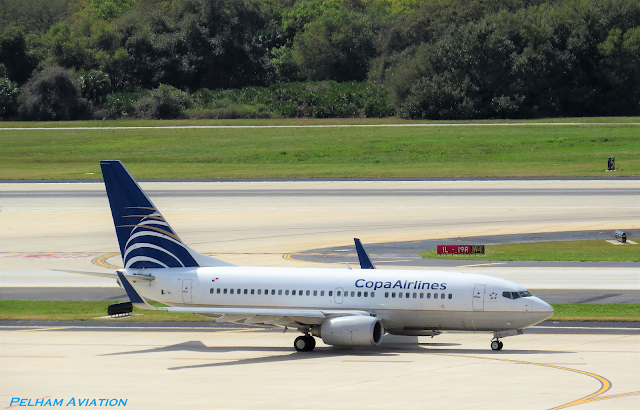Atlanta to Seoul 5 Year Route Analysis
Atlanta
to Seoul 5 Year Route Analysis
August
19, 2019
By:
Michael Gutta
In this edition of the Pelham Aviation blog I decided
to look at the past 5 years of travel data from Hartsfield-Jackson
International Airport (ATL) in Atlanta, Georgia to Incheon International
Airport (ICN) in Seoul, South Korea. The inspiration for this post comes after
having a connection at ATL and taking off directly past a Korean Air 747-8i parked
at gate F1 of the international terminal. I decided to look back at the one-way
travel data for this city-pair which has been served by Korean Air, Delta Air
Lines, and Asiana Air Lines (cargo only). Per AirwaysMag.com, Korean Air has
been flying into Atlanta since June 2002. Delta previously offered service for
a brief period and then resumed service on June 3, 2017. Asiana’s seasonal
cargo service seems to have ended on this route. I investigated the total
market between these two cities, the split between carriers, and finally, the
different aircraft types that have been flown on this route.
In the initial year of my study (2014) nearly one
hundred thousand passengers flew directly from Atlanta to Seoul, when the
passenger route was served only by Korean Air. This passenger total decreased
the next two years down to eighty-five thousand one-way passengers in 2016
before rebounding spectacularly in 2017 and 2018. In the 5-year period from
2014-2018 the annual passenger count doubled to nearly two hundred thousand in
2018. Just as important, the load factor on this route has increased from a
paltry 65% in 2015 to a robust 86% in 2018. This performance of increasing
passenger numbers was likely not coincidental, but a product of the growing
relationship between Korean Air and Delta. Having both been founding members of
the SkyTeam alliance, they entered a code-sharing agreement in 2016 and then
agreed to a joint-venture in 2017, which was implemented on March 28, 2018.
This relationship has grown in recent years as Delta has reshaped their Pacific
network after the acquisition of Northwest Airlines. Since Korean and Delta are
the only two airlines offering passenger service, and they now have a
joint-venture agreement, I decided not to delve deeper into the passenger
numbers by carrier.
Since Asiana Airlines only offered cargo service,
I decided to look at the amount of cargo transported from Atlanta to Seoul over
this time period as well. Asiana operated seasonally for the first three years
before dropping the service, while Delta was a new entrant for the final two
years of this period. The numbers for both Delta and Korean are belly cargo
numbers as they did not fly cargo-only aircraft. There was a noticeable
increase in Korean Air’s cargo numbers after Asiana eliminated their service.
Unfortunately, the cargo totals contracted for both Delta and Korean from 2017
to 2018.
The final piece to this investigation was the
breakdown of aircraft types flown on this route. I sorted the aircraft and
airlines below by the number of departures unsurprisingly being led by three
Korean aircraft. Korean Air has operated a total of 5 different aircraft types
on this route, led by the Boeing 777-300. The world’s largest passenger
aircraft, the Airbus A380, was used second most with just over one-fourth of
the departures during this five-year span. I was lucky enough to spot one these
taxiing in Atlanta several years ago but didn’t get a chance for a photo. The
inspiration for this blog, the Korean 747-8i, came in third with just over 12%
of departures. The Delta Air Lines pair of the brand-new A350-900 and B777-200
came in fourth and fifth. Finally, the all-cargo Asiana B747-400F was sixth,
and with very minor share were the Korean 777-200 and 747-400.
Though not surprising due to the growing
relationship between Korean Air and Delta, I learned through this investigation
that the passenger count has nearly doubled in the last five years from Atlanta
to Seoul. I also learned that Asiana operated an all-cargo service on this
city-pair, though it is now discontinued. Perhaps most intriguing to me are the
aircraft used on this route with the A380, 747-8i, and Delta’s new A350-900
being used. This route is listed as 7,153 miles and has a travel time of nearly
15 hours so being on a large, comfortable, and new aircraft would be very nice
for this route. With Atlanta being such a large airport there is always the
opportunity to see something cool but having the luck to take off from Runway
9L and spot the Korean Air 747-8i was just extra special.
- https://airwaysmag.com/airlines/delta-resumes-atlanta-seoul-softening-relations-korean-air/
- https://news.delta.com/delta-and-korean-air-launch-world-class-joint-venture-partnership
- https://news.delta.com/delta-equity-investment-deepens-ties-joint-venture-partner-korean-air







Comments
Post a Comment